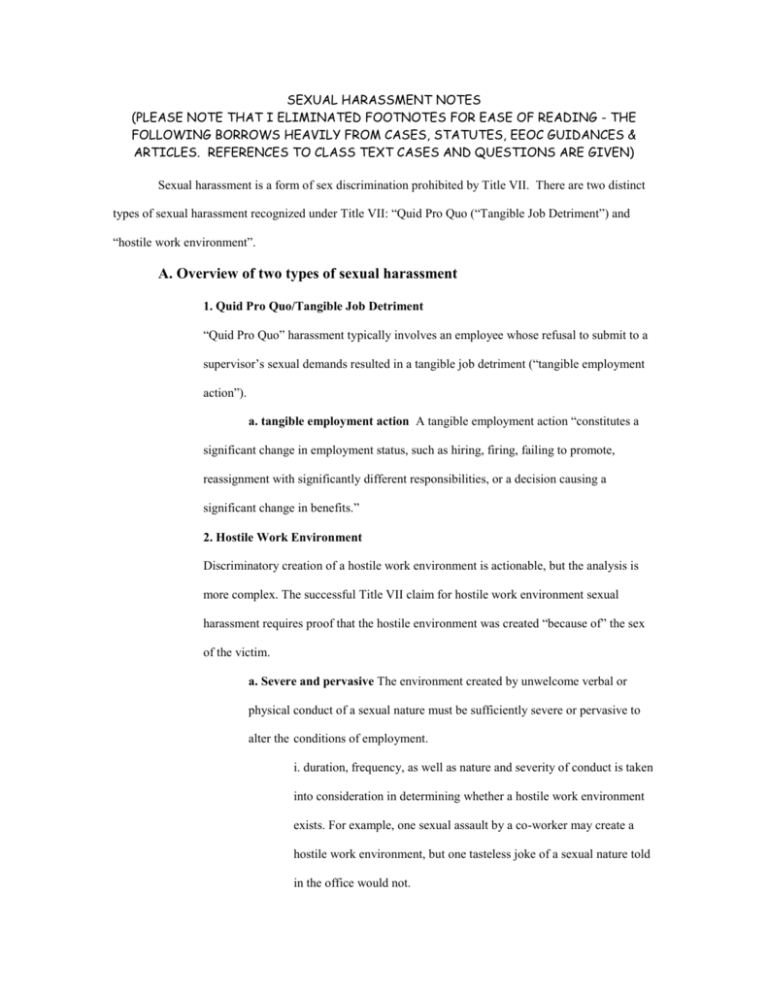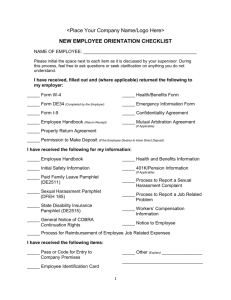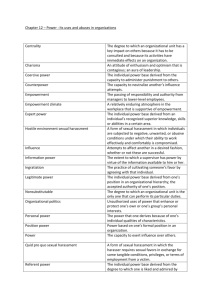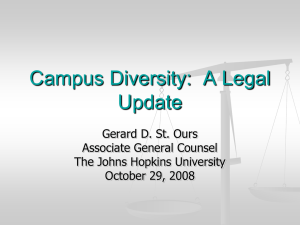
SEXUAL HARASSMENT NOTES
(PLEASE NOTE THAT I ELIMINATED FOOTNOTES FOR EASE OF READING - THE
FOLLOWING BORROWS HEAVILY FROM CASES, STATUTES, EEOC GUIDANCES &
ARTICLES. REFERENCES TO CLASS TEXT CASES AND QUESTIONS ARE GIVEN)
Sexual harassment is a form of sex discrimination prohibited by Title VII. There are two distinct
types of sexual harassment recognized under Title VII: “Quid Pro Quo (“Tangible Job Detriment”) and
“hostile work environment”.
A. Overview of two types of sexual harassment
1. Quid Pro Quo/Tangible Job Detriment
“Quid Pro Quo” harassment typically involves an employee whose refusal to submit to a
supervisor’s sexual demands resulted in a tangible job detriment (“tangible employment
action”).
a. tangible employment action A tangible employment action “constitutes a
significant change in employment status, such as hiring, firing, failing to promote,
reassignment with significantly different responsibilities, or a decision causing a
significant change in benefits.”
2. Hostile Work Environment
Discriminatory creation of a hostile work environment is actionable, but the analysis is
more complex. The successful Title VII claim for hostile work environment sexual
harassment requires proof that the hostile environment was created “because of” the sex
of the victim.
a. Severe and pervasive The environment created by unwelcome verbal or
physical conduct of a sexual nature must be sufficiently severe or pervasive to
alter the conditions of employment.
i. duration, frequency, as well as nature and severity of conduct is taken
into consideration in determining whether a hostile work environment
exists. For example, one sexual assault by a co-worker may create a
hostile work environment, but one tasteless joke of a sexual nature told
in the office would not.
The conduct must be “unwelcome” by the victim. A work environment tainted by sexual conduct
that was welcomed by the victim and in which he or she participated does not constitute sexual harassment
under Title VII. Whether the conduct was subjectively “unwelcome” is an issue of fact, meaning that an
investigator and/or a jury must decide this.
Recognizing that employees often quietly tolerate behavior they genuinely find offensive, courts
do not view plaintiff’s acquiescence or “voluntary” participation as necessarily establishing that the victim
welcomed the conduct.
Further, as shown by Meritor Savings Bank v. Vinson (text p. 275), even a consensual sexual
relationship between adult employee and supervisor is not necessarily “welcome” within the meaning of
hostile work environment. Implicit or express pressure to engage in such a relationship given, for example,
the supervisor-employee relation, could lead a factfinder to determine that this relationship was
“unwelcome” by the employee. (Thus, many employers have “no fraternization” policies regarding
supervisory-employee relationships - we will explore this under the topic of “Workplace Privacy.”)
B. Reasonableness Standard in Hostile Work Environment Claims
The conduct creating a “hostile work environment” must be both objectively and subjectively
offensive. The victim must show that he or she subjectively perceived the behavior as abusive. Further, the
conduct must be shown to create an environment that a reasonable person would find hostile or abusive.
In determining whether conduct is objectively unreasonable, courts recognize that not all conduct
that may be characterized as sexual creates a hostile work environment within the meaning of Title VII. A
single instance of unwelcomed touching, casual flirting, or random physical compliments probably would
not result in a reasonable person finding that working conditions had been adversely affected. However,
repeated requests for a sexual relationship may create a workplace climate that is objectively offensive. The
focus of the reasonableness standard’s application in hostile work environment claims is whether the
reasonable person would agree with the victim that his or her job was made more difficult due to the
conduct in question.
1. Reasonable person/woman/ victim standard:
In Ellison v. Brady (Text p. 285), the “reasonable victim” standard was adopted to analyze
whether the behavior complained of created a hostile work environment. This helps ensure that the
factfinder (e.g. an investigator) considers the situation from the viewpoint of the victim. Thus, a male
investigator of a complaint made by a female would consider the facts from a woman’s vantage point rather
than his own male perspective. While this was not at issue in the case, the decision also would call for a
female investigator to consider the facts from a male’s perspective in a case of a male complainant.
C. Same-Sex Harassment
While California FEHA protects against sexual orientation discrimination in the workplace, Title
VII does not cover sexual orientation discrimination. However, Title VII does protect against
same-sex harassment.
1. Oncale v. Sundowner Offshore Services (text p. 264): In this case, Justice Scalia, writing for
the majority of the U.S. Supreme Court, reminds us that sexual harassment is a form of gender
discrimination that protects both men and women. The Court had rejected the presumption that an
employer would not discriminate against his own race in employment. Similarly, the Court would not
presume that men could not discriminate against men, or women against women. Thus, since harassment is
a form of discrimination, it follows that men could sexually harass men and women could sexually harass
women at work in violation of Title VII.
a. What is not sexual harassment: Justice Scalia also set forth that ordinary horseplay
or mild office flirtation is not what is meant by “sexual harassment.” Rather, Title VII protects against
conduct that is so objectively offensive that the terms and conditions of employment are altered for the
victim because of his or her gender.
b. How to draw the inference of discrimination in a same-sex harassment case:
Proof of discriminatory intent in same-sex harassment (proof that the victim is suffering adverse terms and
conditions of employment because of his or her gender) could be offered in the following ways:
1. homosexual desire
2. General hostility to the presence of the victim’s gender in the workplace (e.g.
a male physician shows hostility towards male nurses)
3. Comparative evidence on the difference between how the harasser treats the
two genders in the workplace. (i.e. “equal opportunity harassers” may escape Title VII liability).
D. Employers’ Liability and the Affirmative Defense
Employers covered by Title VII face liability for the sexual harassment of their employees.
1. Co-Worker Harassment: Under both California’s FEHA and Title VII, liability for the
harassing conduct of co-workers is limited to employers’ negligence: If an employer knows or should have
known of the questionable conduct by failed to respond adequately to correct it, then the employer faces
liability for the co-worker’s harassment.
2. Supervisory Harassment: Supervisory harassment places a higher level of liability on the
employer: the supervisor’s position of authority within the employer’s organization makes his or her acts
attributable to the employer. Thus, the employer is “vicariously liable” for the actions of the supervisor.
What if the employer is unaware of the supervisor’s conduct?
In two 1998 decisions, the United States Supreme Court addressed the issue of employers’
vicarious liability for supervisory harassment. In Burlington Industries, Inc. v. Ellerth and Faragher v. City
of Boca Raton,(text p. 291) the Court distinguished between supervisory harassment resulting in a tangible
job detriment, and a hostile work environment created by a supervisor that did not lead to a tangible
employment action.
a. Strict Liability for supervisory harassment - tangible job detriment: An employer
is “strictly liable” for supervisory harassment resulting a tangible job detriment such as termination or
demotion, regardless of whether it was aware of the supervisor’s actions. This means that the employer is
liable for injuries caused by the supervisor’s harassment regardless of whether or not the employer was
aware of the supervisor’s conduct.
If this seems harsh, consider the situation: an employer has placed a supervisor in a position
where he or she can abuse their power - and the supervisor has done so.
b. Strict Liability for supervisory harassment not resulting in a tangible job
detriment - affirmative defense available:
When no tangible employment action resulted from the supervisor’s harassment, the employer may raise an
affirmative defense.
The affirmative defense available to employers facing liability for supervisory harassment that did
not result in a tangible job detriment has two requirements.
i. Basic requirements of the affirmative defense:
1. First, the employer must have exercised reasonable care to prevent
and correct promptly any sexually harassing behavior.
2. Second, either the plaintiff employee unreasonably failed to take
advantage of any preventive or corrective opportunities provided by the
employer, or the employer took prompt and effective action after the
employee availed himself or herself of the employer’s anti-harassment
policy and procedure.
Therefore, to preserve the affirmative defense against strict liability for supervisory harassment,
employers must properly communicate a written anti-harassment policy and offer effective mechanisms for
reporting and resolving complaints. Once a complaint is made, the employer must undertake a prompt and
effective investigation and effectively remedy any harassment it discloses.
ii. California FEHA does not recognize affirmative defense
The California Court of Appeal has rejected the application of the affirmative defense in a
supervisory harassment case brought under California FEHA. This does not mean California employers
should ignore the need for training, policies, and investigations. All these measures can help prevent
harassment from occurring, or at least avoid litigation arising from it. (A victim who gains relief from the
employer will not be likely to make a complaint with the Department of Fair Employment and Housing).
PLEASE REFER TO THE CLASSROOM HANDOUT ON “PRESERVING THE AFFIRMATIVE
DEFENSE” FOR THE GUIDANCE ON CREATION OF POLICIES AND REPORTING SYSTEMS, AND
ON EFFECTIVE INVESTIGATIONS.
E. OTHER TYPES OF LIABILITY FROM WORKPLACE SEXUAL
CONDUCT:
Employees can sue employers for personal injury such as defamation, assault and
battery, invasion of privacy, and intentional infliction of emotional distress, without
making a statutory claim of sexual harassment.
G. ANSWERS TO CHAPTER 8 CHAPTER-END QUESTIONS:
1. No. Not without more. There is no indication that the activity is unwelcome,
severe, or pervasive.
2. Probably not. The court said that this is not the type of situation that would
unreasonably interfere with the employee’s work performance.
3. Not without more - this does not appear to be severe or pervasive conduct.
4. Probably not. The key facts are that the ex-boyfriend has left her alone and that
he does not appear to have any supervisory authority over her.
5. Probably not without more.
6. Yes - if the requirements are present.
7. The court determined that, while the joke was in poor taste, severity and
pervasiveness was absent.
8. Margaret could bring a claim for sexual harassment under Title VII - the fact
that the alleged harasser is also female does not bar such a claim.
9. Trick question - this is not an employer-employee relationship.
10. Pat should immediately investigate the claim using the handout you received
in class on preserving the affirmative defense, of course! Even in a case of co-worker
harassment, a prompt and effective investigation is necessary, especially since the
employer now “knows or should know” of the concern because Trudy has complained to
Pat the supervisor.









